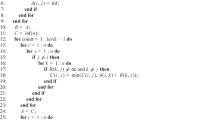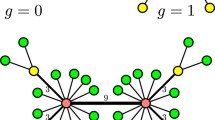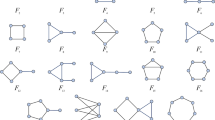Abstract
Newman’s measure for (dis)assortativity, the linear degree correlation coefficient \(\rho _{D}\), is reformulated in terms of the total number N k of walks in the graph with k hops. This reformulation allows us to derive a new formula from which a degree-preserving rewiring algorithm is deduced, that, in each rewiring step, either increases or decreases \(\rho _{D}\) conform our desired objective. Spectral metrics (eigenvalues of graph-related matrices), especially, the largest eigenvalue \(\lambda _{1}\) of the adjacency matrix and the algebraic connectivity \(\mu _{N-1}\) (second-smallest eigenvalue of the Laplacian) are powerful characterizers of dynamic processes on networks such as virus spreading and synchronization processes. We present various lower bounds for the largest eigenvalue \(\lambda _{1}\) of the adjacency matrix and we show, apart from some classes of graphs such as regular graphs or bipartite graphs, that the lower bounds for \(\lambda _{1}\) increase with \(\rho _{D}\). A new upper bound for the algebraic connectivity \(\mu _{N-1}\) decreases with \(\rho _{D}\). Applying the degree-preserving rewiring algorithm to various real-world networks illustrates that (a) assortative degree-preserving rewiring increases \(\lambda _{1}\), but decreases \(\mu _{N-1}\), even leading to disconnectivity of the networks in many disjoint clusters and that (b) disassortative degree-preserving rewiring decreases \(\lambda _{1}\), but increases the algebraic connectivity, at least in the initial rewirings.
Similar content being viewed by others
References
M.E.J. Newman, Phys. Rev. E 67, 026126 (2003)
J. Berg, M. Lässig, Phys. Rev. Lett. 89, 228701 (2002)
M.E.J. Newman, Phys. Rev. Lett. 89, 208701 (2002)
L. Li, D. Alderson, J.C. Doyle, W. Willinger, Internet Mathematics, 2, 431 (2005)
J. Zhao, L. Tao, H. Yu, J. Luo, Z. Cao, Y. Li, Chinese Phys. 16, 3571 (2007)
M. Boguñá, R. Pastor-Satorras, A. Vespignani, Phys. Rev. Lett. 90, 028701 (2003)
J.D. Noh, Phys. Rev. E 76, 026116 (2007)
M. Piraveenan, M. Prokopenko, A.Y. Zomaya, Europhys. Lett. (EPL) 84, 28002 (2008)
P. Van Mieghem, Graph Spectra for Complex Networks, Cambridge University Press (Cambridge, U.K., to appear 2010)
M. Boguñá, R. Pastor-Satorras, Phys. Rev. E 66, 047104 (2002)
P. Van Mieghem, J. Omic, R.E. Kooij, IEEE/ACM Transactions on Networking 17, 1 (2009)
J.G. Restrepo, E. Ott, B.R. Hunt, Phys. Rev. E 71, 036151 (2005)
P. Van Mieghem, Performance Analysis of Communications Systems and Networks (Cambridge University Press, Cambridge, U.K., 2006)
M.A. Fiol, E. Garriga, Disc. Math. 309, 2613 (2009)
Z. Nikoloski, N. Deo, L. Kucera, Discrete Mathematics and Theoretical Computer Science (DMTCS), proc. AE, EuroComb 2005 (2005), pp. 239–244
M. Fiedler, Czech. Math. J. 23, 298 (1973)
J.G. Restrepo, E. Ott, B.R. Hunt, Phys. Rev. E 76, 056119 (2007)
D. Bienstock, O. Günlük, Networks 24, 195 (1994)
S. Zhou, R.J. Mondragón, New J. Phys. 9, 173 (2007)
Y. Shiloach, Inf. Process. Lett. 12, 89 (1981)
H.N. Gabow, An efficient reduction technique for degree-constrained subgraph and bidirected network flow problems, Proc. of the 15th Annual ACM Symposium on the Theory of Computing, 1983, pp. 448–456
M.R. Garey, D.S. Johnson, Computers and Intractability: A Guide to the Theory of NP-Completeness (W.H. Freeman, 1979)
D. Eppstein, Z. Galil, G.F. Italiano, A. Nissenzweig, Journal of the ACM 44, 669 (1997)
Author information
Authors and Affiliations
Corresponding author
Rights and permissions
About this article
Cite this article
Van Mieghem, P., Wang, H., Ge, X. et al. Influence of assortativity and degree-preserving rewiring on the spectra of networks. Eur. Phys. J. B 76, 643–652 (2010). https://doi.org/10.1140/epjb/e2010-00219-x
Received:
Published:
Issue Date:
DOI: https://doi.org/10.1140/epjb/e2010-00219-x




